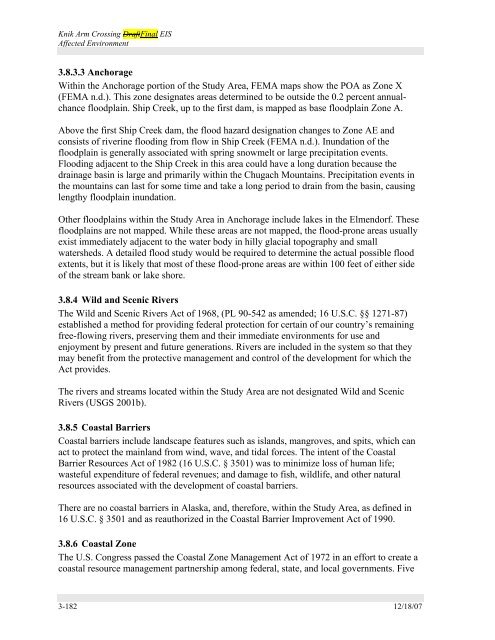3.0 Affected Environment - Knik Arm Bridge and Toll Authority
3.0 Affected Environment - Knik Arm Bridge and Toll Authority
3.0 Affected Environment - Knik Arm Bridge and Toll Authority
You also want an ePaper? Increase the reach of your titles
YUMPU automatically turns print PDFs into web optimized ePapers that Google loves.
<strong>Knik</strong> <strong>Arm</strong> Crossing DraftFinal EIS<br />
<strong>Affected</strong> <strong>Environment</strong><br />
3.8.3.3 Anchorage<br />
Within the Anchorage portion of the Study Area, FEMA maps show the POA as Zone X<br />
(FEMA n.d.). This zone designates areas determined to be outside the 0.2 percent annualchance<br />
floodplain. Ship Creek, up to the first dam, is mapped as base floodplain Zone A.<br />
Above the first Ship Creek dam, the flood hazard designation changes to Zone AE <strong>and</strong><br />
consists of riverine flooding from flow in Ship Creek (FEMA n.d.). Inundation of the<br />
floodplain is generally associated with spring snowmelt or large precipitation events.<br />
Flooding adjacent to the Ship Creek in this area could have a long duration because the<br />
drainage basin is large <strong>and</strong> primarily within the Chugach Mountains. Precipitation events in<br />
the mountains can last for some time <strong>and</strong> take a long period to drain from the basin, causing<br />
lengthy floodplain inundation.<br />
Other floodplains within the Study Area in Anchorage include lakes in the Elmendorf. These<br />
floodplains are not mapped. While these areas are not mapped, the flood-prone areas usually<br />
exist immediately adjacent to the water body in hilly glacial topography <strong>and</strong> small<br />
watersheds. A detailed flood study would be required to determine the actual possible flood<br />
extents, but it is likely that most of these flood-prone areas are within 100 feet of either side<br />
of the stream bank or lake shore.<br />
3.8.4 Wild <strong>and</strong> Scenic Rivers<br />
The Wild <strong>and</strong> Scenic Rivers Act of 1968, (PL 90-542 as amended; 16 U.S.C. §§ 1271-87)<br />
established a method for providing federal protection for certain of our country’s remaining<br />
free-flowing rivers, preserving them <strong>and</strong> their immediate environments for use <strong>and</strong><br />
enjoyment by present <strong>and</strong> future generations. Rivers are included in the system so that they<br />
may benefit from the protective management <strong>and</strong> control of the development for which the<br />
Act provides.<br />
The rivers <strong>and</strong> streams located within the Study Area are not designated Wild <strong>and</strong> Scenic<br />
Rivers (USGS 2001b).<br />
3.8.5 Coastal Barriers<br />
Coastal barriers include l<strong>and</strong>scape features such as isl<strong>and</strong>s, mangroves, <strong>and</strong> spits, which can<br />
act to protect the mainl<strong>and</strong> from wind, wave, <strong>and</strong> tidal forces. The intent of the Coastal<br />
Barrier Resources Act of 1982 (16 U.S.C. § 3501) was to minimize loss of human life;<br />
wasteful expenditure of federal revenues; <strong>and</strong> damage to fish, wildlife, <strong>and</strong> other natural<br />
resources associated with the development of coastal barriers.<br />
There are no coastal barriers in Alaska, <strong>and</strong>, therefore, within the Study Area, as defined in<br />
16 U.S.C. § 3501 <strong>and</strong> as reauthorized in the Coastal Barrier Improvement Act of 1990.<br />
3.8.6 Coastal Zone<br />
The U.S. Congress passed the Coastal Zone Management Act of 1972 in an effort to create a<br />
coastal resource management partnership among federal, state, <strong>and</strong> local governments. Five<br />
3-182 12/18/07
















